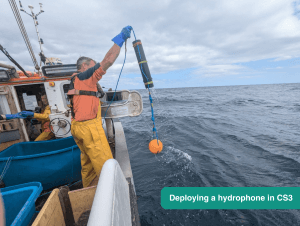The sun has set on the first project year of CIBBRiNA, making this a fitting moment to reflect on the foundations we’ve laid so far as we strive to minimise – and where possible eliminate – the bycatch of Endangered, Threatened and Protected species in Europe. Here, we highlight some of our key outputs so far and progress within our case studies, and look to events coming up in our second project year.
Prioritising stakeholder engagement
As part of finalising our Consortium Agreement for partners, we’ve drawn up a Code of Conduct. The Code underpins our proactive work to foster a ‘Safe Working Environment’ – a collaborative space characterised by mutual trust, respect, and understanding of different perspectives. The intent of the Safe Working Environment is for everyone who is involved in CIBBRiNA – in whatever form – to feel fully able to share information and knowledge and work together to achieve lasting change for bycatch mitigation in Europe.
Equally essential to creating and maintaining our Safe Working Environment is the CIBBRiNA Stakeholder Engagement and Communication Strategy, which we signed off earlier in 2024 following an interactive process of feedback and revision with our CIBBRiNA partners and Stakeholder Advisory Board members. We’re now translating key components of the Strategy into other languages commonly spoken by our partners and other stakeholders, to enhance its accessibility.
A final output we want to share with you is our website. Our one-page splash site has grown into a full series of pages filled with information about the work of CIBBRiNA and the people driving it, with plenty more content to come, including reports on the results of our collaborations with fishers, interviews with stakeholders, and details of forthcoming events.
Starting up the CIBBRiNA “engine”: our case studies
CIBBRiNA’s eight case studies together cover small- and large-scale fisheries using gillnets, deep-water longlines, surface longlines, pelagic trawls, and bottom trawls. While this diversity of fishing methods means that exploring a diversity of bycatch mitigation measures is a must, the overlaps in terms of ETP species bycatch and the complexities of addressing this also creates plenty of opportunity for knowledge exchange. As a result, the case studies have been hard at work forging connections with fishers, other case studies, and stakeholders key to the success of CIBBRiNA’s trials and research.
While much of the year has been taken up with laying the foundations for this success, some case studies have already carried out their first at-sea trips and trials. Highlights include:
CS1 (Northern gillnets): Trials in Iceland have been testing the efficacy of pingers (battery-powered devices that emit sound) and “pearls” (small acrylic spheres that bounce back the sound produced by small cetaceans) – in reducing bycatch of one of the smallest whale species, the harbour porpoise.
While full statistical analysis is yet to be done, early results suggest potential solutions that could be applied across the North Sea and the Baltic Sea.
CS3 (UK static nets):
The current focus in this case study is the collection of vital data on how harbour porpoises and common dolphins behave around static nets. This will help us establish a “behavioural baseline” – in other words, how do these marine mammals behave around nets without devices such as pingers, versus their behaviour when such devices are added?
The data is being collected using hydrophones and depth sensors attached to the fishing nets. An emerging challenge is that the sensors make the nets more buoyant, which affects their ability to catch fish. However, thanks to the strong working relationship between the fishers and scientists involved in CS3, adaptations are in progress.
CS6 (UK longlines): This case study focuses closely on seabirds such as northern fulmar and northern gannet. One measure already found to be extremely effective in fisheries around the world is the use of bird-scaring lines (also known as streamer lines or tori lines). These are brightly-coloured streamers that are deployed from the stern of a vessel during line-setting operations and – as you can probably guess – keep birds away from longlines while the baited hooks are still within their reach.
But bird-scaring lines need to be designed differently depending on the type of fishery. That’s why CS6 is in conversation with skippers to design a line that is lighter than previously-tested versions, which should be more effective and manageable for crew to use in their daily fishing work.
The case study is also exploring how to make hooks on longlines sink quicker, with initial signs of success seen in the use of longer free float ropes – a brilliant example of how small changes could add up to make a lot of difference in efforts to reduce ETP species bycatch.
The near-horizon for CIBBRiNA
As well as ongoing progress in the case studies and related research under our different work themes, we have a number of meetings and other events coming up, including:
- Online communication seminar in November 2024, for partners involved in our case studies: Organised by ProSea, this seminar is designed to provide information and enable participants to practice skills for communicating successfully in a project with many stakeholders involved – such as CIBBRiNA.
- In-person capacity-building course in February 2025, for stakeholders involved in our case studies: This course is designed to enhance cooperation and participatory skills, based on toolkits, extensive cooperative research in the Netherlands, and outputs of the GAP2 project.
- Stay tuned for updates on other events we’ve got coming up in early 2025, including a turtle bycatch mitigation workshop and our project’s second in-person meeting.
Keen to get involved in our work?
We’re still seeking other expert stakeholders to take part in our case studies across Europe, particularly those from among the worlds of fishing, policy, science, and eNGOs – so get in touch with us today!


